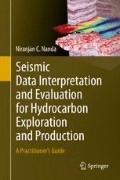Abstract
Seismic reflection events are caused by the impedance contrasts at layer interfaces having a minimum width (Fresnel Zone). Seismic studies to represent reliably the subsurface geology, require quality data, which depend on signal-to-noise ratio and resolution, the latter being the ability to image thin geologic features separately. This calls for a seismic broad-bandwidth source consisting of both low and high frequencies that can improve resolution limits to layer thicknesses.
Seismic reflections record attributes such as amplitude, phase, polarity, arrival time and velocity that can be measured or estimated. The attributes define the shape and arrival time of reflection waveforms which depend on rock properties. Estimation of rock properties from seismic waveforms and their vertical and lateral changes in time and space is the essence of seismic interpretation.
Appropriate choice of seismic display modes and plotting scales are also important.
Access this chapter
Tax calculation will be finalised at checkout
Purchases are for personal use only
References
Anstey AN (1977) Seismic interpretation- the physical aspects, records of short course the new seismic interpreter. IHRDC of Boston, Massachusettes, 2–109 to 2-111A, 3–1 to 3–19 & 3–65 to 3–85
Clement WA (1977) A case history of geoseismic modeling of basal Morrow- Springer sandstone. AAPG Mem 26:451–476
Lindsey JP (1989) The Fresnel zone and its interpretive significance. Lead Edge 8:33–39
Meckel LD Jr, Nath AK (1977) Geologic consideration for stratigraphic modeling and interpretation. AAPG Mem 26:417–438
Sheriff RE (1977) Limitations of resolution of seismic reflections and geologic detail derivable from them. AAPG Mem 26:3–13
Sun S, Bancroft JC (2001) How much does the migration aperture actually contribute to the migration result? CREWS Res Rep 13:573–581
Vail PR, Todd RG, Sangree JB (1977) Chronostratigraphic significance of seismic reflections. AAPG Mem 26:99–116
Widess MB (1973) How thin is thin bed? Geophysics 38:1176–1180
Author information
Authors and Affiliations
Rights and permissions
Copyright information
© 2016 Springer International Publishing Switzerland
About this chapter
Cite this chapter
Nanda, N.C. (2016). Seismic Reflection Principles: Basics. In: Seismic Data Interpretation and Evaluation for Hydrocarbon Exploration and Production. Springer, Cham. https://doi.org/10.1007/978-3-319-26491-2_2
Download citation
DOI: https://doi.org/10.1007/978-3-319-26491-2_2
Published:
Publisher Name: Springer, Cham
Print ISBN: 978-3-319-26489-9
Online ISBN: 978-3-319-26491-2
eBook Packages: Earth and Environmental ScienceEarth and Environmental Science (R0)

